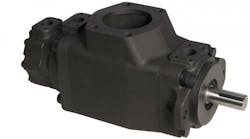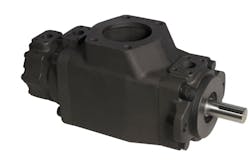EVO vane pump and motor line comes in three series — PT6, PT7 and PT67 — with single, tandem, triple and quad units, through drives, add-a-pump covers, motors, and quiet models. They are rated for maximum pressures from 1450 to 4650 psi, speeds from 400 to 3600 rpm, and offer displacements from 0.35 to 16.46 in.3 (5.7 to 269.8 cc). Standard housings and exterior components feature impregnated rust-resistant coating. Cartridge kits are standard in bi-rotation configurations for mobile and industrial applications. Shafts are constructed wit
h high tensile steel alloy for long life and operation.
Hydrogenated Nitrile Butadiene Rubber (HNBR) type seals are standard rather than Buna-N. By using HNBR, vane products provide greater temperature resistance and a wider range of fluid compatibility including petroleum based hydraulic oil, motor oil, transmission fluid, grease, water/glycol and invert emulsions, HFA, HFB and HFC fluids. HNBR seals also offer greater resistance to ozone, aging and weather. Temperature range limits are also increased with HNBR type seals (-25°F to 300°F).
Phosphate ester and similar type fluids still require Viton type seals.
Permco, (800) 626-2801, www.permco.com


